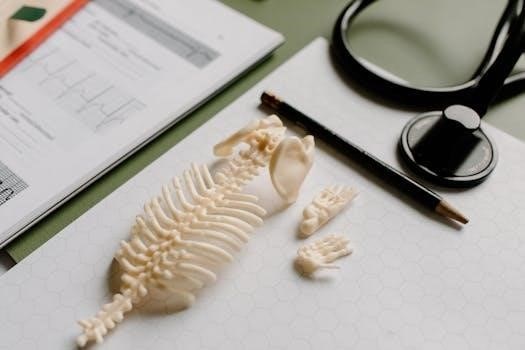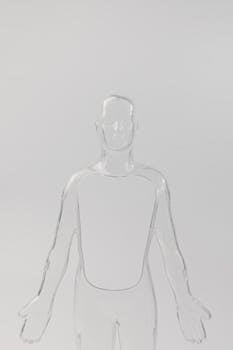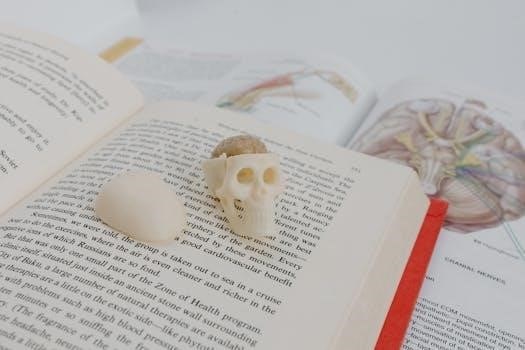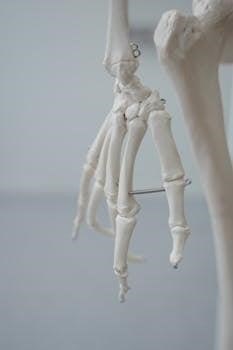exploring anatomy and physiology in the laboratory pdf

Lab manuals are essential for practical learning in anatomy and physiology. They guide students through experiments, dissections, and observations, reinforcing theoretical knowledge. These manuals often include detailed procedures and illustrations.
Purpose and Scope of Lab Manuals
The primary purpose of anatomy and physiology lab manuals is to provide a structured approach for students to engage with the subject matter through hands-on activities. These manuals serve as a comprehensive guide, detailing experiments that allow students to explore the structure and function of the human body. The scope typically includes a wide range of exercises, from microscopic examinations of tissues to dissections of anatomical models or specimens, and physiological experiments to study body processes. Furthermore, lab manuals often aim to develop students’ scientific skills, such as observation, data collection, and analysis. They reinforce theoretical concepts, providing a practical perspective on the complex workings of the human body. The scope extends to fostering critical thinking, problem-solving, and the ability to apply knowledge to real-world scenarios. Moreover, lab manuals help ensure safety and proper handling of equipment and materials.
Types of Laboratory Exercises
Laboratory exercises include dissections of various specimens, physiological experiments, and microscopic studies. These activities aim to deepen understanding of anatomical structures and physiological processes through practical engagement.
Dissection Activities with Different Specimens
Dissection activities are a cornerstone of anatomy lab work, offering hands-on experience with various specimens. Students may dissect rats, cats, or fetal pigs, exploring anatomical structures firsthand. These activities involve detailed observation and identification of organs and tissues. The use of different specimens allows for comparative anatomy studies, highlighting variations among species. Dissections may include labeling of anatomical features, which enhances understanding of spatial relationships within the body. These exercises are crucial for developing practical skills and a deep appreciation of the complexity of anatomical systems. Careful dissection techniques are emphasized, promoting precise manipulation and thoughtful observation. The use of models also supplements the real specimens, reinforcing the learning process. Dissection activities provide invaluable practical training in anatomical studies.
Physiological Experiments in the Lab
Physiological experiments in the lab offer a practical approach to understanding bodily functions. These experiments often involve the scientific method, requiring students to design, test, and analyze results. Students may explore various physiological processes such as blood typing, muscle activity, or the effects of exercise on the body. Such experiments allow students to directly observe and measure physiological responses. These activities focus on data collection, analysis, and interpretation of results, enhancing critical thinking skills. Experiments may require the use of specialized equipment, teaching students proper handling and calibration techniques. Lab sessions often involve group work, promoting collaborative learning and discussion of findings. The application of theoretical knowledge to practical scenarios is a key component of physiological experiments, reinforcing the link between function and structure. By engaging in these experiments, students gain deeper comprehension of physiological mechanisms.

Key Components of a Lab Manual
Effective lab manuals include clear objectives, detailed procedures, and helpful illustrations. These components ensure students understand the goals, methods, and concepts of each exercise, facilitating learning.
Objectives and Learning Outcomes
Clearly defined objectives and learning outcomes are crucial for effective lab sessions. These statements articulate what students should know or be able to do upon completion of a lab exercise. For example, objectives may include identifying specific anatomical structures, performing physiological experiments, or explaining key physiological processes. Learning outcomes ensure that each activity has a purpose and contributes to the student’s overall understanding. By stating objectives and outcomes upfront, students gain a clear sense of direction and can evaluate their learning progress. Furthermore, these learning outcomes often align with course goals and assessment criteria. These elements are essential for a focused and impactful laboratory experience, maximizing the educational benefit of each session. Specific learning goals are typically laid out in the lab manual to guide student learning.
Procedures and Instructions
Detailed procedures and instructions are the backbone of any successful lab manual. These sections meticulously outline each step of an experiment or dissection. They provide students with clear, sequential guidance to ensure accurate and safe execution. Instructions include information on required materials, equipment setup, and the proper techniques to use. They often incorporate safety precautions and warnings to minimize risks. Well-written procedures prevent errors, promote consistency in results, and allow students to focus on learning rather than troubleshooting. Specific instructions can be found for activities such as labeling anatomical structures, dissecting specimens, or performing physiological experiments. These instructions are designed to guide students through the process, allowing for a more hands-on and engaging experience. Proper procedures are essential for accurate data collection and reliable learning.
Illustrations and Diagrams
Illustrations and diagrams are crucial components of anatomy and physiology lab manuals. They provide visual aids that enhance understanding and complement written instructions. These visuals help students identify anatomical structures, understand complex processes, and interpret experimental results. Diagrams may depict body cavities, organ systems, cellular structures, and physiological pathways. Illustrations can range from simple line drawings to detailed color images of specimens and models. These visual elements help learners grasp spatial relationships, enhance their understanding of the body’s organization, and provide a reference for dissecting specimens. They also facilitate the interpretation of microscopic images and the identification of different cell types. The inclusion of detailed illustrations and diagrams ensures that students can accurately visualize concepts, which helps to reinforce learning and improve their skills in the laboratory setting.

Specific Lab Manual Examples
Several lab manuals exist, including Marieb’s, ABAC’s, and Hubley and Imholtz’s. These provide structured activities, detailed instructions, and various learning resources for anatomy and physiology students.
Human Anatomy & Physiology Laboratory Manual by Marieb
The Human Anatomy & Physiology Laboratory Manual by Marieb offers a wide array of experiments tailored for healthcare students. This manual focuses on understanding the structure and function of the human body through hands-on activities. The exercises use artwork from Marieb/Hoehn’s Human Anatomy & Physiology textbook, enhancing comprehension and visual learning. The manual provides structured guidance, ensuring students grasp key anatomical and physiological concepts effectively. It is frequently updated to align with the latest scientific findings. The manual is often available in both print and digital formats, offering flexibility for different learning preferences. This text is designed to work with Mastering A&P, providing interactive resources.
ABAC Anatomy and Physiology I Lab Manual
The ABAC Anatomy and Physiology I Lab Manual, second edition, is a comprehensive guide designed for students at Abraham Baldwin Agricultural College. This manual, licensed under CC BY 4.0, is authored by Heather Cathcart, Gina Profetto, and others, ensuring a collaborative approach to learning. The manual offers a variety of exercises including the labeling of anatomy, dissection of models, and physiological experiments. It provides options for dissection using rats, cats, or fetal pigs. The manual emphasizes the scientific method. It also incorporates engaging elements, like crime scenes and superheroes, to make learning more interactive. This text aims to enhance student understanding of key anatomical and physiological principles.
Human Anatomy and Physiology 1 and 2 Laboratory Manual by Hubley and Imholtz
The “Human Anatomy and Physiology 1 and 2 Laboratory Manual” by Mark Hubley and Alex Imholtz serves as a practical guide for students in Bio 2050 and 2060 courses. Published by Hayden Mcneil, this manual provides a structured approach to understanding the complexities of the human body. It is designed to complement the theoretical aspects of anatomy and physiology through hands-on exercises and experiments. The manual offers detailed procedures, helping students grasp key concepts effectively. It serves as a valuable resource, facilitating deeper learning and comprehension of the human body’s functions and structures. The manual also includes various activities aimed at reinforcing learning.

Online Resources and Instructor Materials
Online platforms like Mastering A&P offer interactive study modules. Digital and PDF versions of lab manuals provide flexibility. These resources support both students and instructors.
Mastering A&P Integration
Mastering A&P is a powerful online tool that enhances the learning experience in anatomy and physiology labs. It seamlessly integrates with lab manuals, offering a wide array of interactive resources. This platform provides access to over 3000 dynamic study module questions, aligning with textbook content, including materials from Marieb/Hoehn’s “Human Anatomy & Physiology”. The integration allows students to engage with the material in a more dynamic and personalized way, helping them to grasp complex concepts effectively. Mastering A&P’s resources include virtual dissections, quizzes, and animations that complement hands-on lab work. Furthermore, it also offers progress tracking features allowing instructors to monitor student performance and tailor teaching strategies. This integration ultimately aims to improve comprehension, retention, and overall success in the course. The digital platform’s adaptability ensures that students can learn at their own pace and in a method that best suits their needs.
Availability of Digital and PDF Versions
The accessibility of anatomy and physiology lab manuals has greatly expanded with the prevalence of digital formats. Many publishers now offer lab manuals in both digital and PDF versions, allowing for flexible learning and convenient access. These formats enable students to study on various devices, such as laptops, tablets, and smartphones, promoting anytime, anywhere learning. Digital versions often include interactive elements, enhancing engagement beyond the capabilities of print manuals. PDF versions offer the advantage of easy download and offline access, making them ideal for students with limited internet connectivity. The availability of these digital formats reduces the need for bulky physical copies, supporting a more environmentally friendly approach to education. Moreover, digital formats often come at a lower cost than traditional print versions, making them a more affordable option for students. These digital tools enhance accessibility and cater to diverse learning preferences, ensuring that learning resources are available to all.

Safety and Lab Protocols
Safety is paramount in anatomy and physiology labs. Strict adherence to disinfection protocols, proper handling of specimens, and lab rules are crucial for a safe learning environment.
Disinfection and Lab Rules
Maintaining a sterile environment is crucial in any anatomy and physiology lab. Proper disinfection of lab tables after every dissection and experiment is mandatory, ensuring the safety of all students. The use of the laboratory space is strictly limited to assigned lab exercises, preventing unauthorized activities. Familiarity with the location of safety equipment, such as eyewash stations and first aid kits, is essential. Students must adhere to all instructions given by the instructor regarding the proper handling of chemicals and solutions. Specific procedures, such as wearing appropriate personal protective equipment, must be followed at all times. Eating, drinking, and applying cosmetics are strictly prohibited. These rules are designed to minimize risks and facilitate a productive and safe learning experience. Any breach of safety guidelines may result in suspension.
Proper Handling of Specimens and Equipment
Handling specimens and equipment correctly is paramount in the anatomy and physiology lab. Students must treat all specimens with respect, whether they are preserved or fresh. Always wear gloves when handling specimens to avoid contamination and exposure to potential biohazards. Use dissecting tools and equipment only as instructed, taking care not to damage specimens or injure yourself. Microscopes should be handled with care, avoiding any forceful movements. When using chemicals and solutions, be sure to handle them with caution and dispose of them properly. After using any lab equipment, clean it thoroughly to ensure that it is ready for the next user. Avoid touching surfaces with contaminated gloves. Report any equipment malfunctions immediately. Follow the instructor’s guidance closely to avoid any accidents or damage.